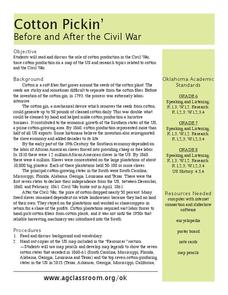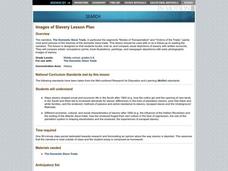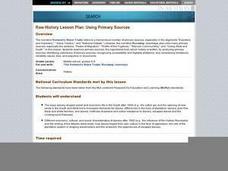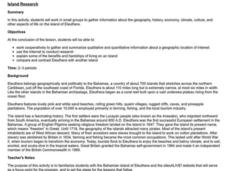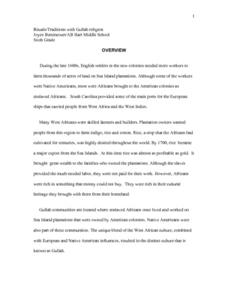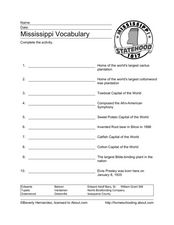C3 Teachers
Economics of Slavery: How Did Cotton Sow the Seeds of Panic?
An inquiry-based lesson challenges high schoolers to research and identify the economic forces and inventions that impacted the cotton industry. Researchers consider how the use of slavery impacted the economic growth of the United States.
National Endowment for the Humanities
Factory vs. Plantation in the North and South
North is to factory as South is to plantation—the perfect analogy for the economy that set up the Civil War! The first lesson plan in a series of five helps teach beginners why the economy creates a driving force for conflict. Analysis...
Curated OER
Kensington Mansion: Plantation, Sharecroppers, Tenants
Eleventh graders investigate the significance of the Kensington Mansion. In this South Carolina history instructional activity, 11th graders take field trips to the mansion and research primary and secondary sources about plantations,...
Curated OER
Cotton Pickin' Before and After the Civil War
Students explore the impact of cotton. In this economics lesson, students listen to a lecture presented by their instructor on the Southern crop of cotton and its impact on the South prior to and following the Civil War. Students...
Crafting Freedom
Harriet Jabocs and Elizabeth Keckly: The Material and Emotional Realities of Childhood in Slavery
Through the journals written by Harriet Jacobs and Elizabeth Keckly, young readers gain insight into the lives of two enslaved children on nineteenth-century plantations.
Curated OER
COTTON AND SLAVERY IN ARKANSAS
Fifth graders read about the cotton industry in America and demonstrate the roll of slaves picking and removing seeds from a boll of cotton. The relationship between slaves and cotton production is established.
Curated OER
Background to the Conflict: Pre-Civil War Days
The American Civil War was a complex test of a relatively young democracy in the mid-nineteenth century. Discuss the events and factors that led to the Civil War with a thorough slideshow presentation.
Curated OER
When Rice Was King
Students examine the origins of rice production in the South. They identify the steps involved in rice cultivation, examine photos of plantation life, conduct interviews, and research the economic base of their own community.
Curated OER
James Hopkinson's Plantation. Planting Sweet Potatoes
In this primary source analysis worksheet, students analyze the photograph that features freedmen planting sweet potatoes. Students respond to 1 short answer question about the photograph.
Curated OER
Rice Plantation
Eighth graders study the importance of rice as a cash crop and the crop's dependency on slave labor during the settlement of coastal South Carolina. They explain the importance of the rice plantations to South Carolina's colonial economy.
Curated OER
The Antebellum South
Your history students will be on the edges of their seats during this fascinating presentation, which details the abolition movement and slave life during the Antebellum period in the American South. Students will be left agape at the...
Curated OER
Images of Slavery
Young scholars analyze the ways slavery shaped social and economic life in the South after 1800, methods of passive and active resistance to slavery; escaped slaves and the Underground Railroad, and the ending of the Atlantic slave trade.
Curated OER
George Washington Carver
In this mathematics learning exercise, students identify and define various vocabulary terms related to George Washington by solving addition problems. There are nine problems to solve on the sheet.
Curated OER
Images from South Carolina Cotton Mills
Fifth graders write a paragraph comparing their lives to the lives of a child working in South Carolina during the early 1900's. In this Industrial Revolution lesson plan, 5th graders explore primary and secondary sources to teach them...
Curated OER
Whitewashing Southern History
Students discuss the fact and fiction of slavery in the South. After viewing a video on two New Orleans plantations, they determine the accuracy of the facts presented. In the computer lab, they visit various sites and examine which ones...
Curated OER
RAW HISTORY: USING PRIMARY SOURCES
Young scholars analyze the ways slavery shaped social and economic life in the South after 1800, how slaves forged their own culture in the face of oppression; and the role of the plantation system in shaping slaveholders and the enslaved.
Curated OER
Fugitive Slave Narratives
Learners analyze the ways slavery shaped social and economic life in the South after 1800, the different economic, cultural, and social characteristics of slavery after 1800, and the ending of the Atlantic slave trade.
Curated OER
Island Research
Students will work in small groups to gather information about the geography, history, economy, climate, culture, and other aspects of life on the island of Eleuthera. Lesson contains adaptations for all levels.
Curated OER
The Pre-Civil War Era (1815–1850)
For this online interactive U.S. history worksheet, students respond to 9 short answer and essay questions about 19th century America. Students may check some of their answers on the interactive worksheet.
Curated OER
Rituals/traditions with Gullah religion
Sixth graders discuss some of the earliest people who lived in each region in order to comprehend how humans interacted with the environmental conditions at that time. They make connections to present-day regions including...
Curated OER
Mississippi Challenge
In this state facts worksheet, students read the statements about Mississippi. Students select the correct answer to complete the 10 statements.
Curated OER
Mississippi Vocabulary
In this vocabulary activity activity, students read the phrases associated with the state of Mississippi. Students use the word bank to complete the 10 statements.
Garden of Praise
George Washington Carver Word Search
This is a simple and straightforward word search activity involving terms related to the life and career of George Washington Carver.
Garden of Praise
George Washington Carver Test
This is a standard multiple-choice assessment on the life and ideas of George Washington Carver. It includes 20 questions on topics covering information about his birth and education, major career moves, teaching principles, ethics, etc.





